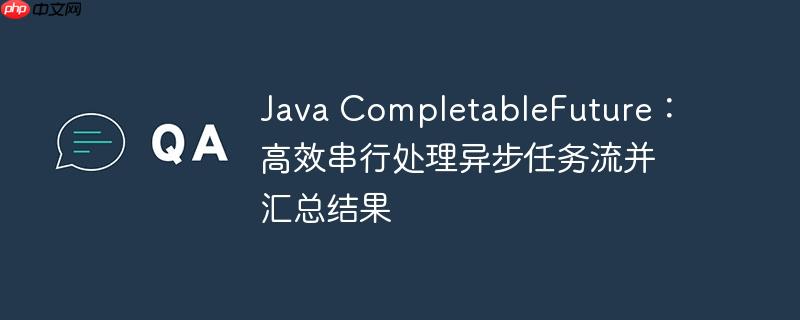
在现代java应用开发中,completablefuture 提供了一种强大且灵活的异步编程模型。然而,当需要串行执行一系列异步任务,并将每个任务的结果汇总到一个集合中时,会遇到一些特定的挑战。这尤其常见于业务流程需要严格按顺序处理数据,但每个处理步骤本身又是耗时操作的场景。
考虑一个场景:我们有一个 process 方法,它返回一个 CompletionStage<Integer>,代表一个耗时且异步的业务操作。现在,我们需要对一系列输入数据依次调用这个 process 方法,并最终将所有结果收集到一个 List<Integer> 中,同时确保每个 process 调用都是在前一个完成后才开始。
import java.time.LocalDateTime;
import java.util.ArrayList;
import java.util.List;
import java.util.concurrent.CompletableFuture;
import java.util.concurrent.CompletionStage;
import java.util.stream.Collectors;
import java.util.stream.IntStream;
public class SequentialCompletableFuture {
/**
* 模拟一个耗时的异步业务处理过程。
* 返回一个CompletionStage,其结果为输入a加10。
*/
private CompletionStage<Integer> process(int a) {
return CompletableFuture.supplyAsync(() -> {
System.err.printf("%s dispatch %d\n", LocalDateTime.now(), a);
// 模拟长时间运行的业务逻辑
try {
Thread.sleep(10); // 模拟耗时
} catch (InterruptedException e) {
Thread.currentThread().interrupt();
}
return a + 10;
}).whenCompleteAsync((e, t) -> {
if (t != null)
System.err.printf("!!! error processing '%d' !!!\n", a);
System.err.printf("%s finish %d\n", LocalDateTime.now(), e);
});
}
}在尝试解决上述问题时,开发者可能会采用以下两种直观但存在局限性的方法:
方法一:使用 thenApplyAsync 嵌套 join()
// 第一次尝试
List<Integer> arr = IntStream.range(1, 10).boxed().collect(Collectors.toList());
CompletionStage<List<Integer>> resultStage1 = CompletableFuture.completedFuture(new ArrayList<>());
for (Integer element : arr) {
resultStage1 = resultStage1.thenApplyAsync((retList) -> {
// 在thenApplyAsync内部阻塞等待另一个CompletableFuture的结果
Integer a = process(element).toCompletableFuture().join();
retList.add(a);
return retList;
});
}
List<Integer> computeResult1 = resultStage1.toCompletableFuture().join();
System.out.println("Method 1 Results: " + computeResult1);分析: 这种方法确实实现了串行执行和结果收集。thenApplyAsync 会在前一个阶段完成后执行其回调函数。由于 process(element).toCompletableFuture().join() 在 thenApplyAsync 的回调内部被调用,它会阻塞当前线程直到 process 任务完成。这确保了任务的串行性。然而,这种模式被认为是“不雅”的,因为它在异步回调内部执行了阻塞操作。CompletableFuture 的设计理念是避免阻塞,而是通过回调链来处理异步结果。此外,每次 thenApplyAsync 都会调度一个新任务到线程池,如果 process 内部也使用了线程池,可能会导致不必要的线程上下文切换和资源消耗。
立即学习“Java免费学习笔记(深入)”;
方法二:使用 thenCombineAsync
// 第二次尝试
List<Integer> arr = IntStream.range(1, 10).boxed().collect(Collectors.toList());
CompletionStage<List<Integer>> resultStage2 = CompletableFuture.completedFuture(new ArrayList<>());
for (Integer element : arr) {
// thenCombineAsync 会并发执行两个CompletionStage
resultStage2 = resultStage2.thenCombineAsync(process(element), (existingList, newResult) -> {
existingList.add(newResult);
return existingList;
});
}
// 尝试获取结果,但由于并发执行,顺序可能不确定或不符合预期
// List<Integer> computeResult2 = resultStage2.toCompletableFuture().join();
// System.out.println("Method 2 Results: " + computeResult2); // 结果可能不按顺序分析: thenCombineAsync 的设计目的是将两个独立的 CompletionStage 的结果合并。这意味着 resultStage2 和 process(element) 会被并发执行。在循环中,process(element) 会立即被调度执行,而不会等待前一个 process 任务完成。因此,这种方法无法保证任务的串行执行顺序,其输出结果的顺序将是混乱的,与我们的需求不符。
thenCompose 是 CompletableFuture 中用于串行化异步操作的关键方法。它允许你将一个 CompletionStage 的结果作为输入,并返回一个新的 CompletionStage。这正是实现链式异步操作,即一个异步任务完成后再启动下一个异步任务所需要的。
这种方法的核心思想是维护一个表示当前链条末尾的 CompletionStage<Void>,并在每个步骤中,在前一个任务完成后,执行 process 任务,然后将 process 的结果添加到外部的 List 中。
public class SequentialCompletableFuture {
// ... (process 方法同上)
public static void main(String[] args) {
SequentialCompletableFuture app = new SequentialCompletableFuture();
List<Integer> arr = IntStream.range(1, 10).boxed().collect(Collectors.toList());
// 方案一:使用 thenCompose 和外部列表
CompletionStage<Void> loopStage = CompletableFuture.completedFuture(null); // 初始化一个已完成的Void阶段
final List<Integer> resultList = new ArrayList<>(); // 用于收集结果的外部列表
for (Integer element : arr) {
loopStage = loopStage
// thenCompose: 等待loopStage完成,然后执行process(element)并返回其CompletionStage
.thenCompose(v -> app.process(element))
// thenAccept: 等待process(element)完成,然后将其结果添加到resultList
.thenAccept(resultList::add);
}
// 阻塞等待所有任务完成
loopStage.toCompletableFuture().join();
System.out.println("Method 1 (thenCompose + external list) Results: " + resultList);
// 预期输出:[11, 12, 13, 14, 15, 16, 17, 18, 19] 且按顺序调度和完成
}
}原理分析:
此方法将结果列表作为 CompletionStage 的结果在链中传递,避免了对外部共享可变状态的直接依赖(尽管 ArrayList 本身是可变的)。
public class SequentialCompletableFuture {
// ... (process 方法同上)
public static void main(String[] args) {
// ... (方案一代码)
// 方案二:使用 thenCompose 在链中传递列表
List<Integer> arr = IntStream.range(1, 10).boxed().collect(Collectors.toList());
CompletionStage<List<Integer>> listStage = CompletableFuture.completedFuture(new ArrayList<>()); // 初始阶段包含一个空列表
for (Integer element : arr) {
listStage = listStage
// thenCompose: 等待当前listStage完成,其结果是当前的列表
.thenCompose(list -> app.process(element) // 执行process任务
.thenAccept(list::add) // process结果添加到传入的列表中
.thenApply(v -> list) // 将修改后的列表作为此thenCompose的结果传递给下一个阶段
);
}
List<Integer> finalResultList = listStage.toCompletableFuture().join();
System.out.println("Method 2 (thenCompose + list in chain) Results: " + finalResultList);
// 预期输出:[11, 12, 13, 14, 15, 16, 17, 18, 19] 且按顺序调度和完成
}
}原理分析:
thenCompose vs. thenApply:
线程池管理:
错误处理:
最终结果的获取:
通过本文的探讨,我们理解了在 CompletableFuture 中实现异步任务串行执行并收集结果的挑战。thenApplyAsync 配合 join() 虽然能实现串行,但不够优雅;thenCombineAsync 则会导致并发执行,不适用于串行场景。
最终,我们掌握了两种基于 thenCompose 的推荐解决方案:
选择哪种方案取决于具体的场景和个人偏好,但两者都能有效地解决 CompletableFuture 串行执行和结果收集的问题,并提供了比初始尝试更健壮和优雅的实现方式。掌握 thenCompose 的正确使用是编写高效、可维护的 CompletableFuture 异步代码的关键。
以上就是Java CompletableFuture:高效串行处理异步任务流并汇总结果的详细内容,更多请关注php中文网其它相关文章!

每个人都需要一台速度更快、更稳定的 PC。随着时间的推移,垃圾文件、旧注册表数据和不必要的后台进程会占用资源并降低性能。幸运的是,许多工具可以让 Windows 保持平稳运行。

Copyright 2014-2025 https://www.php.cn/ All Rights Reserved | php.cn | 湘ICP备2023035733号